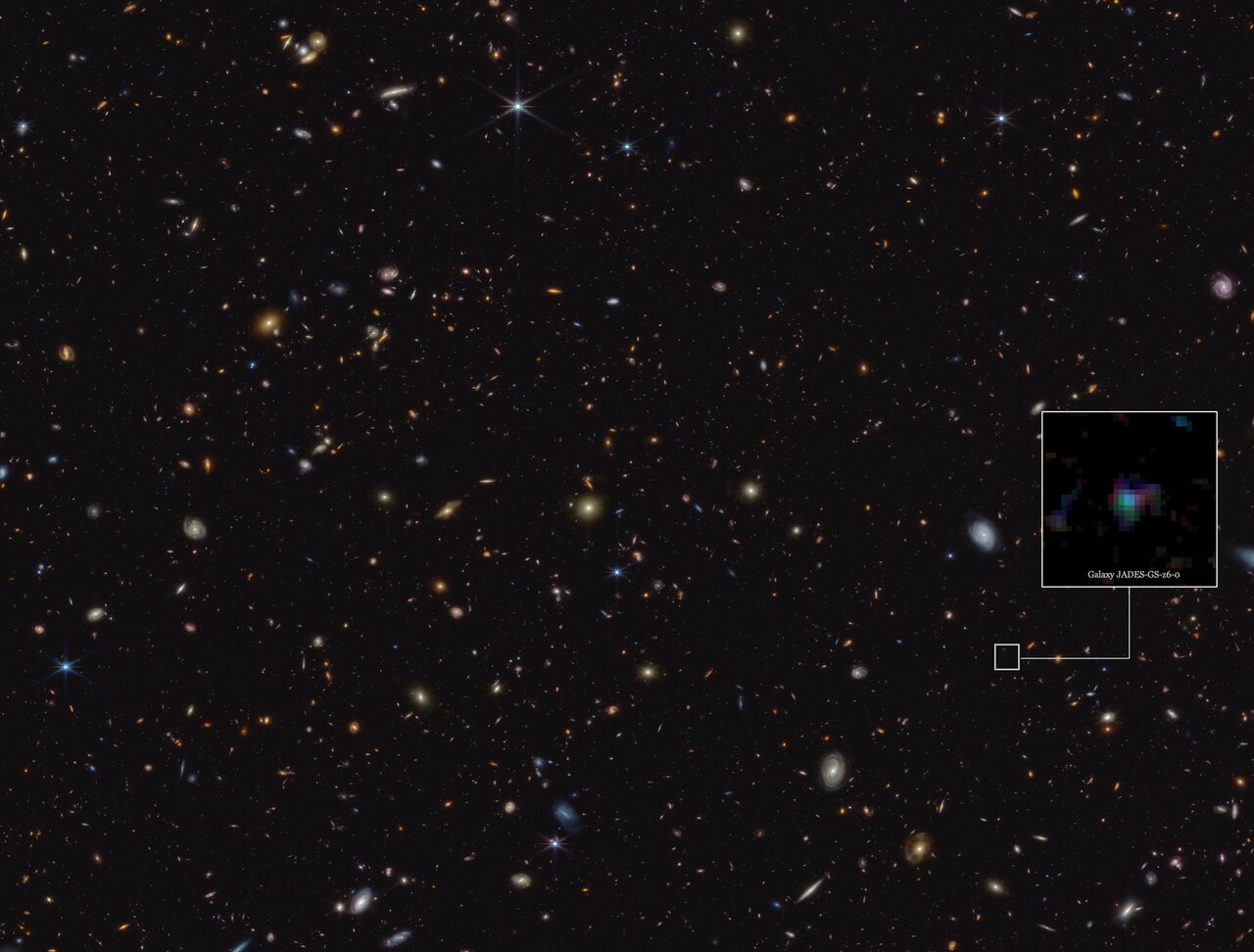
NCBJ scientists investigate the origin of carbon dust in one of the oldest known galaxies
14-07-2025
A team of researchers from the Astrophysics Division of the National Centre for Nuclear Research (NCBJ), led by dr hab. Ambra Nanni, has conducted a pioneering study of the origin of carbon dust in one of the most distant galaxies known to science – JADES–GS-z6-0. Data collected by the James Webb Space Telescope (JWST) has provided new insights into the presence of complex molecules, such as polycyclic aromatic hydrocarbons (PAHs), in the early Universe, less than a billion years after the Big Bang.
The research was conducted as part of the project „DINGLE – Dust IN Galaxies: Looking through its Emission” funded by the National Science Centre. The team based their work on the data collected by JWST, but the pivotal contribution was to analyse it in detail and to model the evolution of dust in primeval galaxies. – Our goal was to understand where the carbon-containing dust particles came from in such a young galaxy and how they could have formed there so early – says dr hab. Ambra Nanni, project leader and first author of the paper, which has just been published in Astrophysical Journal Letters.
Understanding the origin and processes governing the evolution of cosmic dust is crucial. The dust affects many processes in the Universe and can provide information about star formation, the interstellar medium (ISM) and galaxies. However, acquiring this data requires a large research infrastructure, such as space telescopes. A breakthrough in this field is the James Webb Space Telescope, which allows scientists from around the world to study the most distant objects with unprecedented accuracy and provide invaluable data for analysis.
The team from NCBJ’s Astrophysics Division utilised the exceptional sensitivity of the JWST to study the galaxy properties that were previously inaccessible in the high-redshift Universe. The main Focus was put on the so-called „UV bump” around 2175 Å observed in galaxies’ rest-frame spectra within the first billion years after the Big Bang, which likely indicates the presence of large carbon-bearing molecules in their ISM, e. g. in the form of polycyclic aromatic hydrocarbons (PAHs). The galaxy under consideration, JADES–GS-z6-0, formed less than a billion years after the Big Bang, was observed as part of the JADES programme (JWST Advanced Deep Extragalactic Survey), and shows an exceptionally strong „UV bump” in its spectrum, comparable to those observed in the Milky Way. This indicates enrichment of PAHs already at very early epochs, when the Universe is expected to be too young for producing this component.
In order to trace the evolution of the dust, and in particular of PAHs, in the ISM of the galaxy under study, Dr Nanni’s group used a chemical evolution model taking into account physical processes such as the injection of dust by stellar sources, its removal by supernova shocks, and dust grain growth in the ISM. The simulations made it possible to compare the theoretical spectra with the one obtained by JWST and to trace different possible paths for the formation for PAHs. – We performed the simulations with different underlying assumptions – for example, with and without consideration of the dust grain growth process. In both cases, the results indicate that PAHs could account for 4–4.6% of the total dust mass in the galaxy under study, explains Ambra Nanni, author of the publication.
Several formation paths for PAHs can take place in galaxies, notably their synthesis around so-called AGB (asymptotic giant branch) stars and by shattering of large dust grains in the interstellar medium. – However, our model indicates that these processes are not sufficient to explain this amount of hydrocarbons at this cosmic epoch. It appears that additional phenomena, such as the injection of PAHs from massive stars (winds and/or Type II supernovae) and/or dust production in the ISM of galaxies, are needed to explain it – the researcher adds.
The work of the astrophysicists shows once again how important it is to understand the phenomena governing dust formation and destruction. A thorough understanding of these processes may open the way to a more complete description of the evolution of galaxies and the early Universe.
The full results of the study are detailed in the publication: A. Nanni, M. Romano, D. Donevski, J. Witstok, I. Shivaei, M. Fioc, P. Sawant, Origins of Carbon Dust in a JWST-Observed Primeval Galaxy at z ~6.7, ApJL 988, L5, https://iopscience.iop.org/article/10.3847/2041-8213/ade2e5




